By Jeffrey A. Rendall, Photos By Kevin Gaydosh
WHITE SULPHUR SPRINGS, WV – Mineral waters, railroads, General Robert E. Lee, WWII ‘Enemy Alien Diplomats,’ Sam Snead, Dorothy Draper and the Cold War Bunker – that’s The Greenbrier, or should it be said, a small sampling of the things that went into making what is perhaps America’s finest all-around resort.
It was nearly impossible to pinpoint a theme to encompass The Greenbrier, because the resort’s history is so varied that its many time capsules wouldn’t fit nicely into one compartment or category. Almost as striking as The Greenbrier’s décor when you first walk in the main entrance, its journey through time reads of improvement, adaptation, espionage, intrigue, celebrity ‘who’s who’ stories and opulent, gentile luxury innovation – occurring all at the same time.
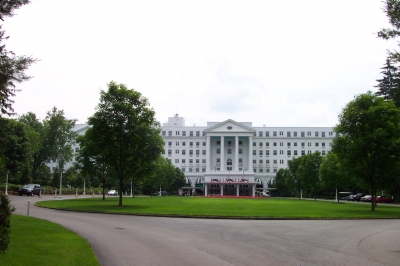 |
| The Greenbrier in 2004. |
Established in 1778, The Greenbrier’s early days were composed of travelers making a long and difficult journey over basically wild terrain to take advantage of its mineral springs.
Bob Conte, The Greenbrier’s Historian, takes the story from here. “There was a whole network of resorts in this area in the early days, and only The Homestead (located in Hot Springs, VA, just over the state border) and The Greenbrier have survived to this day. It wasn’t until about the 1820’s when the old stagecoach road was built that the resort really takes off. Prior to that, it’s a trek over Indian trails to get here, and though we’ve been hosting guests since the late 1770’s – not many at that time – it certainly wasn’t what we would think of today as a fashionable resort.”
What, no big hotel, golf courses and Spa in the days of Washington, Franklin and Jefferson?
Conte continues, “Once the road was built, which is today’s Rt. 60, the old federal highway that Interstate 64 supplanted -- the resort blossoms pretty quickly. Mineral water’s the key, what people were looking for. You’ve got a cooler climate, too, with our elevation of over 2,000 feet along with gentle mountain breezes helping to provide some relief from the heat in the days before air-conditioning. It was strictly a summer resort back then.”
 |
| The Greenbrier may be All-American, but it's still distinctly Southern, too. |
It’s hard to imagine what motivated people to journey for days over very thorny terrain to reach a resort in the middle of the wilderness in pre-Civil War Virginia, but travel they did. In those days, of course, you didn’t find the big white hotel building with pillars in front at the end of your trip – but you did have cottages to stay in, some of which still exist today (with extensive upgrades and renovations over the years).
According to Conte, the central part of today’s resort, the lawn and the golf club, was also the heart of the 19th century resort, too -- a big lawn flanked by cottages. Then, in 1858, the original hotel, known as ‘Old White’ opens. In the second half of the 19th century, you’d see a pretty big resort with the hotel and cottages, the beginnings of a grand summer vacation place – the southern version of the American grand mineral springs resort (the corresponding ‘northern’ example being Saratoga Springs in New York).
Continuing in the southern tradition, Robert E. Lee and several other famous ex-Confederate Army officers visited in the late 1860’s, and the resort was abuzz for a hundred years afterwards remembering.
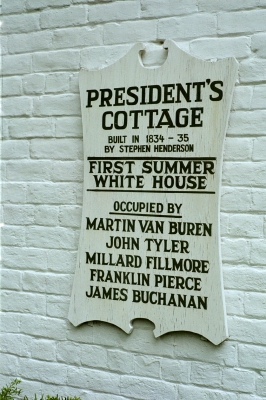 |
| More than a few famous people have visited The Greenbrier. |
In the early 20th century, what we now know as The Greenbrier starts to take shape, with the introduction of the railroad’s ownership. “I’ve always said, the reason why both The Greenbrier and The Homestead survived where the others did not was railroads and golf,” Conte said. “The railroads provided a much easier way for people to get here, and in our case, the funding to build and improve the resort.”
The Chesapeake & Ohio (C&O) Railway purchased the resort in 1910, and has owned it ever since (through mergers, it’s now owned by CSX Corporation), with the minor exception of four years during WWII, when the government leased, then purchased the property to first house enemy foreign diplomats, then for use as a military hospital.
The C&O railroad built The Greenbrier Hotel, which opened in 1913, along with the resort’s first golf course, the CB MacDonald designed Old White Course. The railroad was looking to expand on The Greenbrier’s standing as a strictly summer retreat, bringing in golf and tennis to attract visitors, but also building an enormous indoor pool (it actually opened in 1912, a year before the hotel) – which together with the floors above it, served as The Greenbrier’s Spa for 75 years before the more modern version was completed (it was renovated and enlarged in 2001).
1914 was the year The Greenbrier opened year-round. In 1930, it was virtually re-built and doubled in size. All during this time, it also built on its reputation as a gathering place for the rich and famous, hosting Presidents, foreign dignitaries, celebrities and sportsmen. Sam Snead became the resort’s Head Golf Professional in 1936, and remained in that ceremonial role for the rest of his career.
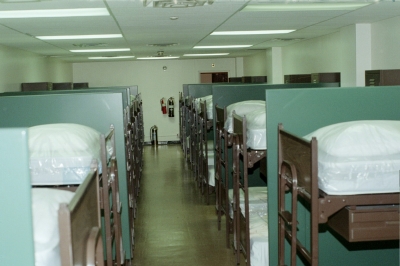 |
| No, this isn't a picture of your Greenbrier Hotel room. It's the sleeping accommodations down in the Bunker -- that thankfully, were never utilized. |
When the country went to war, so did The Greenbrier, in its own capacity. Conte helps with the details: “A lot of people know about The Greenbrier serving as an army hospital during the war, but what’s not as well known was our housing of ‘enemy alien diplomats’ for about six months in early 1942, just after the war started. The Japanese contingent was at The Homestead, and here we held the Germans and Italians.”
The State Department leased the hotel, and the diplomats were treated as regular guests – after all, it was in our best interests to treat them well until our people in the countries overseas could be ‘exchanged.’ What better place than at The Greenbrier? It was large enough, easy to patrol, and far enough removed where there was little or no danger of damaging intelligence being communicated to the enemy.
When the diplomats were exchanged, the US Army acquired The Greenbrier with an agreement in advance to sell the hotel back to the C&O after the war. Over 25,000 soldiers recouped and rehabbed on the grounds of The Greenbrier during the Army’s four years of ownership, some even receiving golf lessons from Sam Snead himself when he was visiting during his leave time with the Navy.
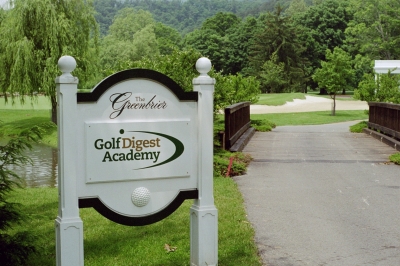 |
| In addition to three outstanding resort courses, The Greenbrier now offers instruction at the Golf Digest Academy. |
After the war, as you’d expect, the hotel pretty much needed a complete overhaul, and the hiring of decorator Dorothy Draper to re-design The Greenbrier’s décor was a decision that impacts the grand resort to this day. As mentioned above, you’ll notice Draper’s dramatic designs the minute you walk in the door.
“It’s a shock to some people,” Conte said. “It wasn’t too long ago, I was talking with a lady from Las Vegas, and I mentioned how some people are shocked when they see it – and she said, “I’m from Las Vegas, and I was shocked when I saw it.”
Draper took a year and a half to completely redecorate the interior of the hotel, the guest rooms, public spaces, cottages, shops, everything – and The Greenbrier still employs the Draper company to keep things looking tasteful and striking. There’ve been lots of changes in the 60 or so years since WW II, but Draper’s black and white marble, stripes, floral patterns and bright colors remain all throughout The Greenbrier’s buildings. It’s certainly something you’ll never forget once you’ve witnessed it.
In those post-war years, many American dignitaries visited and vacationed at The Greenbrier, General-then-President Eisenhower probably the most notable amongst them. As you’d gather, Eisenhower very much enjoyed the golf at the resort, and The Greenbrier’s notorious service and cuisine probably didn’t hurt in his favorable impressions.
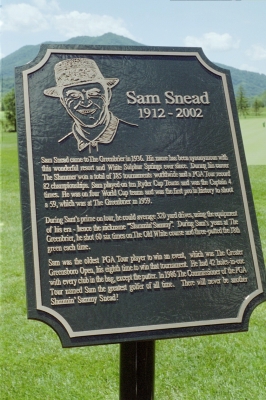 |
| Sam Snead is immortalized just about everywhere at The Greenbrier. Here, at the brand new 'The Snead' golf course at the Greenbrier Sporting Club. |
It’s perhaps because of The Greenbrier’s wartime connections that the C&O railroad was contacted about potentially constructing a bunker/bomb shelter underneath the hotel to house the legislative branch in case of nuclear attack.
“The government was doing something pretty unusual to approach a private company and ask them to build a bunker on their property,” Conte elaborated. “If you’re going to do that, you’re probably going to try and work with someone you’ve got an established relationship with – and there certainly was that connection because of the war years at The Greenbrier.”
Many of the Army’s top brass had visited during the war, including Eisenhower, so there was a certain amount of familiarity with The Greenbrier that made it attractive – in addition to the fact it was a bomb safe distance from Washington DC, fairly easy to get to, yet remote enough to avoid being a target.
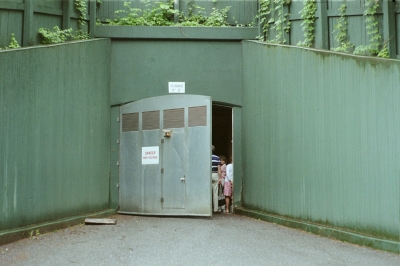 |
| There are only a few entrances to The Greenbrier's Cold War Bunker -- this one's where trucks could deliver supplies. The door weighs 25 tons. |
Construction on The Greenbrier Bunker began in 1959 and was finished in 1962 – and it remained a secret, even from most Greenbrier employees, until 1992. About the ‘secret’ nature of the Bunker, Conte says, “Of course there were rumors floating around, and everybody sort of knew, but sort of didn’t know. Part of the deal with the government was that while the Bunker was being constructed, a whole new wing of the hotel was being added at the same time (on ‘top’ of the Bunker) – so there was building going on, but it seemed like they were building something more substantial than just another hotel wing.”
“And there were rumors from day one, but you couldn’t confirm them. When the secret was finally revealed in 1992 (in a Washington Post article), then everything immediately made sense,” Conte added.
Today, you can tour the Bunker at The Greenbrier, just one of a multitude of activities you can choose from at the resort. Since there’s so much to do, I’ll highlight the activities we took part in, and recommend them all accordingly.
The first is obviously golf. The Greenbrier (rated a Golf Magazine Gold Medal Resort) offers three courses at the resort (and one at the private Sporting Club, if you happen to know a member), all originating from the main clubhouse on property. All the courses have a rich and interesting history, and will be highlighted in separate reviews.
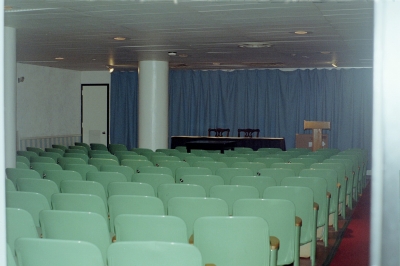 |
| This meeting room would have become the temporary United States Senate Chamber if Congress would've had to relocate. |
One aspect of The Greenbrier experience that everyone enjoys is the cuisine. From finicky kids to the most discerning of connoisseurs, there’s a wealth of excellent eats to choose from. We chose to dine in the casual atmosphere of Sam Snead’s at the Golf Club, as well as a more formal evening meal at The Greenbrier’s Main Dining Room. Both offered excellent gourmet menus, with attentive wait staff and pleasing atmospheres. Breakfast and dinner was included in our package, and one thing’s for sure – you’ll never leave hungry from a meal, unless you so choose!
Traveling with the family is surprisingly easy at The Greenbrier, which offers children’s programs for kids of all ages. For a family-oriented activity, we chose a carriage ride around The Greenbrier grounds, which included a lengthy jaunt through the Old White and Meadows Golf Courses (don’t worry, the trail isn’t actually on the courses!). It was a great way to spend an afternoon, taking in the sights and learning a little bit more about the resort.
Our accommodations were also surprisingly family friendly, having booked one of the Spring Row Cottages. Our cottage included a master bedroom with king bed and a queen-sized sofa bed in the parlor – perfect for young children. The bathroom was quite large and there’s even a dressing area to help prepare for those dressy occasions at the hotel. As mentioned above, the Draper inspired décor was eye-catching and pleasing – if not a bit ‘shocking’ when you first see it.
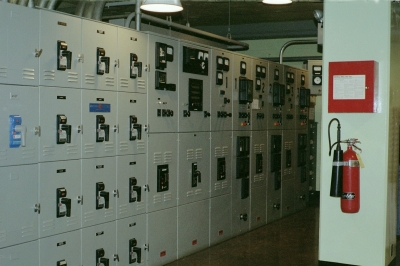 |
| The Bunker was designed to be completely self-sufficient -- from providing its own power, to storing its own water, to disposing of its garbage. When they sealed those doors, nobody gets out until they let you go. |
The Greenbrier itself offers 803 rooms, including 33 suites and 96 guest and estate houses – accommodations for every preference. The hotel rooms are spacious in their own right, and again, all contain that marvelous Draper décor!
Not to be left out was a trip to The Greenbrier Spa – while those golfers amongst us took on the golf courses, my wife Shari headed to the Spa for a treatment – and she was suitably impressed.
“The Greenbrier Spa takes pampering to a higher level, with an escape into paradise – it has every conceivable amenity and treatment to indulge in the ultimate Spa experience to rejuvenate both body and mind. I chose one of The Greenbrier’s signature treatments, Kate’s Black Walnut Scrub. The treatment began with an exfoliation process that blended the finest skin therapy products which remove the dull, rough skin on the surface and left it feeling smoother and softer. After a warm horizontal shower rinse, there’s a full body massage with a rich, hydrating lotion that restored and replenished the skin. This treatment eliminated the skin’s fine lines and left it looking more radiant,” Shari described. Sounds relaxing just hearing about it.
We also signed up for a Bunker tour, which is a 90-minute look into our country’s Cold War past. The Bunker is maintained very much as it looked 12 years ago when the ‘secret’ was let out, and seeing it was a fascinating journey into the mindset that gripped the world in the late fifties and early sixties. Though hardly a luxury hotel, the Bunker could’ve housed up to a thousand people – the entire United States Congress and other legislative personnel, for up to 60 days. (Note: The Bunker will be closed after July 28th to undergo restoration – will re-open for tours in the spring of 2006.)
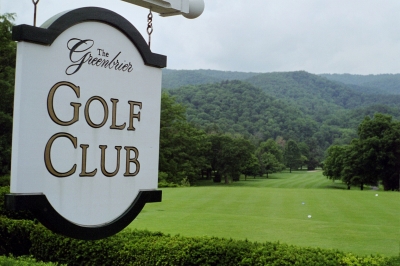 |
| The Greenbrier's three resort courses all start and finish at The Golf Club. Here, the famous 1st tee on the Old White Course. |
Needless to say, there were a multitude of activities, both indoor and outdoor, that we weren’t able to take advantage of in our brief stay – the resort itself may be timeless, but our time at The Greenbrier was finite, indeed. There’s something for everybody at The Greenbrier, however, from those looking strictly to relax to those desiring to be on the go every moment of the day (stopping to eat, of course).
It’s not inexpensive, but if you budget your trip ahead of time, you won’t incur a great deal of additional expenses once you’re there – since meals are included in your package. Shopping? On second thought, you’d better set aside some extra budget just for that!
The Greenbrier truly is a regional treasure, for both its extensive history and very contemporary leisure and recreational offerings. It can’t be categorized – but you’ll certainly see that it’s a fantastic place to visit.
Details:
The Greenbrier
Director of Golf: Robert Harris
The Greenbrier’s Historian: Bob Conte, a very valuable source of information!
Phone: (304) 536-1110; FAX: (304) 536-7854
Website: www.greenbrier.com
| Related Links | Comments on this article? | |
|
Maryland National Golf Club Hollow Creek Golf Club Rocky Gap Resort PB Dye Golf Club in Ijamsville Whiskey Creek Golf Club |
E-mail Jeff Rendall, Editor: jrendall@golftheunitedstates.com |











